
Journal of Theatrical
Combatives June 2002
"True to Middle Earth Cultures": Creating Fighting
Styles - an interview with Tony Wolf.
Copyright 2002 Deborah Klens-Bigman, Ph.D. Introduction
…But everywhere he looked he saw signs of war…out of the East Men were
moving endlessly: swordsmen, spearmen, bowmen…all the power of the Dark
Lord was in Motion. (1)
Beloved by readers for years, J.R.R. Tolkien’s Lord of the Rings
trilogy is now being made into a trio of films by New Zealand director
Peter Jackson. The undertaking involves a veritable army of actors, stunt
people, and techies of all sorts. The culmination of all this creative
activity has resulted with the release of the first film, The Fellowship
of the Ring, at the end of 2001. While, as expected, modifications
were made to the story to accommodate the medium, skeptical Tolkien fans
were amazed at the level of respect accorded to the author’s vision as
well as the high degree of realism achieved by the film.
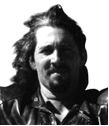 Tony Wolf is one of the legion of behind the scenes workers blessed with
a unique and exacting challenge - rather than accomplish the fight and
battle scenes with generic fight choreography, director Jackson decided
to have him design movement styles for the different cultures and species
of combatants: Orcs, Uruk-hai and others. Drawing on his expertise in martial
arts, combat choreography and a wide variety of indigenous fighting styles
from around the world, Tony created unique styles and taught them to teams
of stunt people. This method then allowed those in charge of the actual
fight scenes to work within a certain framework of tactics and body mechanics
with trained personnel. Tony also worked with motion capture technicians
to create the epic battle scenes, such as the one described in the quote
above.
Tony Wolf is one of the legion of behind the scenes workers blessed with
a unique and exacting challenge - rather than accomplish the fight and
battle scenes with generic fight choreography, director Jackson decided
to have him design movement styles for the different cultures and species
of combatants: Orcs, Uruk-hai and others. Drawing on his expertise in martial
arts, combat choreography and a wide variety of indigenous fighting styles
from around the world, Tony created unique styles and taught them to teams
of stunt people. This method then allowed those in charge of the actual
fight scenes to work within a certain framework of tactics and body mechanics
with trained personnel. Tony also worked with motion capture technicians
to create the epic battle scenes, such as the one described in the quote
above.
When Tony, who is also an editor for EJMAS’s Journal of Manly Arts,
contacted me for a possible interview, I grabbed the opportunity in order
to pursue several ideas concerning both the making of LoTR and how computer
technologies are interpreting human movement. I also wanted to know what
his opinion might be regarding the intersection of stage combat and martial
art practices; a subject in which he is uniquely qualified to comment.
The interview took place via email during March and April 2002 (EJMAS’s
travel budget being non-existent). I hope that the inevitable lack of spontaneity
is more than made up by the thoroughness of Tony’s responses, and the fascinating
subject matter.
*****
Deborah Klens-Bigman: Can you give us a little background on
your training in both martial arts and stage combat?
Tony Wolf: When I was about ten years old I came across a comic-book
mail order course for "Super Powers Made Simple," and I sent off my five
dollars and never heard back from the company. The life-lesson was that
if I wanted to be Batman, I'd have to work it out for myself. It wasn't
a matter of money, and it wasn't going to be simple.
It led me into some pretty obscure areas as I was growing up - old Vaudeville
acts and circus skills, various martial arts styles, professional wrestling,
dance and theatre movement disciplines. I became a sort of amateur anthropologist
of combat and movement forms. I was always fascinated by the basic principles
that united different systems, as well as by the elements that made them
unique.
My father was an actor early in his career, and he was the President
of New Zealand Actor's Equity during the '70s. I was involved in performance
from a pretty early age. I'd been staging fight scenes informally for years,
and I became a fight director more or less by osmosis.
Up until the mid-1990s there was no formal stage combat training available
in New Zealand. In fact that term was quite foreign to the theatre scene
here. Fight scenes were generally strung together by whoever wanted to
do the job, so you’d get ostensibly Elizabethan-era rapier and dagger duels
staged by modern fencing coaches, or brawls staged by actors who’d had
a bit of boxing training. Sometimes it worked, but not often. I ended up
developing a system that identified universal movement and staging principles
that could be applied to any performance combat genre. It was a process,
rather than a collection of techniques or styles.
In 1995 I attended the first International Stage Combat Workshops in
London. That was really my first contact with what the rest of the world
was doing in this field. Later I helped to establish the New Zealand Stage
Combat Society, which maintains a national curriculum for actors and drama
students.
DKB: How did you get what seems to me to be the world's coolest
job?
TW: I had worked with Peter Jackson before, as a stuntman on
Brain
Dead - that was a splatstick zombie movie set in the '50s - and I had
stunt coordinated Forgotten Silver, which was about the amazing
life of Colin McKenzie, the Cecil B. DeMille of silent-era film-making
in New Zealand. "Colin" was actually a product of Peter's imagination and
the "documentary" was a complete hoax. Some people didn't get the joke.
Apparently it's still playing on documentary channels around the world!
Anyway, I happened to know that Peter was intrigued with the idea of
exotic fighting styles. When I heard that he would be directing the Lord
of the Rings, I suggested that the fighting arts of Middle Earth should
be designed from the ground up, in the same way the sets, costumes and
props were being developed. The styles should be organic to the different
races and cultures, rather than the sort of generic "stunt fighting" that
you sometimes see in this sort of movie. That jelled with what he was thinking
and it was my entry into the project.
DKB: Did your work involve all three films or just Fellowship?
TR: Because all three movies were shot simultaneously, the fighting
styles for each one were largely designed during the pre-production phase.
DKB: Would you tell me your "official title" for the film, and
explain what your job entailed on Lord of the Rings?
TR: I was officially the "Cultural Fighting Styles Designer."
I was responsible for the fighting styles of the Orcs, Rohirrim, Uruk-hai,
Gondorians, Elves, Goblins and Easterlings. Each race or culture had its
own sub-styles as well, based on different weapons - Rohan axe and shield,
Elf swordplay, Goblin spear fighting, etc.
I was inspired by the level of detail on the props and costumes that
were being produced, and the weapons, even though many of them would never
be seen in close-up. My ideal was that audiences would be able to tell
the character types apart, even if they were seen in the far distance or
in silhouette, just by the way they moved and used their weapons. I also
wanted each fighting style to be unique to the Middle Earth culture that
produced it, not just a pastiche of "moves" from disparate real-life sources.
The research phase for each style began by studying a particular culture;
costumes, armour, weapons, background stories, biomechanics, physical capabilities
and limitations. We pored over Tolkien's books, of course. There were also
lots of meetings with other designers, graphic artists, the director, and
others.
The key was to start from an intimate understanding of the characters,
then to figure out where "outside influences" - animal predation and defence
techniques, combat tactics, locomotion dynamics, dance and movement styles,
and different martial arts traditions could seamlessly combine to create
something that made sense for our story. It was a synergistic process.
We used the term "fighting style," but we meant something more than
a style in the formal martial arts sense. There's no such thing as an "Orcish
martial art," for example - they're stupid, brutal, chaotic creatures,
and it would be ridiculous if they all suddenly turned into Musashi on
the battlefield. Also, from a practical standpoint, the Orcs had one hundred
and eight different types of weapons and there was no way to create a formal
fighting style for each one. Because the Orcs were so diverse, their “style”
is more tactical than technical.
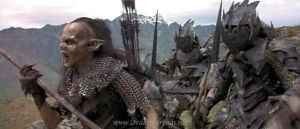
Their fighting techniques, weapons and armour are efficient but ugly,
because they are cannibalised from those of their victims. It's almost
like a grotesque parody of skilled combat techniques, like baboons or hyenas
that have learned to use swords and spears.
By contrast, the Elves are beautiful, magical beings and their martial
arts are exquisitely formal. Elvish swordplay reflects a cultural tradition
that's been refined over thousands of years. I had to approach each culture
on its own terms.
The development phase included a great deal of full-contact sparring,
which was video taped and analysed. We would pit an Uruk-trained sword
and shield fighter against a Rohan-trained spear fighter, for example.
We had to develop special training systems and equipment to safely improvise
fighting, moving and reacting in character, because at that stage we were
going for - I don't want to say "total realism," but as close to that as
we could get. The styles had to function believably as battlefield-worthy
fighting skills before they could be transformed into performance vehicles.
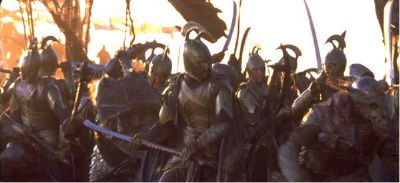
Peter's motto was, "We're not making fantasy movies, these are historical
epics set in Middle Earth." That was a major inspiration for me. The danger
with fantasy is that you can get lazy. "We're making it all up, so who's
to say *this* can't happen?" I wanted the discipline of knowing exactly
what was right for each character, down to the finest detail. Which elements
of 15th century German longsword fencing will work for the Gondorian style?
Can an Orc straighten its arms? Can Elves hear attacks they can't see?
How strong is an Uruk's helmet? You wouldn't believe some of the questions
that we had to answer.
At the same time, we had to be able to break the styles down into key
points so different production departments could modify them according
to their own needs. It was a constant balancing act. After a while I would
literally be watching people walking around the studios and I'd be mentally
translating their movements into Orcish, Elvish, etc.
Fight choreography was another major aspect of the design phase, because
many of the LotR characters have abilities that humans just do not possess.
The Uruk-hai, for example, are strong enough to use powerful edge blocks
with their machete-like swords, and human performers couldn't copy that
action in sparring. They'd wreck their wrists. Likewise, the Elves have
all sorts of superhuman abilities that we could only simulate through pre-arranged
choreography. We developed hundreds, maybe thousands of "quatrains," which
were brief choreographed routines that demonstrated different aspects of
the styles.
Once I was happy with the design it was approved or amended by Peter
Jackson. The final phase was to develop a curriculum for teaching it to
the stunt team, and getting everything down on video and in written form
for reference by other departments (stunts, digital FX, Previz, etc.)
DKB: Can you describe what might be in a given "quatrain" used
in the development of the fighting styles?
TW: The quatrains were situational acting exercises as well as
technical choreographic sets. I also used them to communicate the styles
to different departments within the production, including many people who
knew absolutely nothing about fighting, stunt work, or martial arts.
One quatrain would demonstrate a Goblin archer, for example, scuttling
backwards while firing several arrows at an enemy. Another would show an
Elf swordsman calmly awaiting an onslaught of Orcs, then slicing and dicing
several at once. We had quatrains for mounted fighters, like the warriors
of Rohan, that demonstrated spearing and lancing techniques from horseback.
I also developed "twists," which were variations on individual quatrains
- I'd change one key action and it would give me a slightly different result,
to demonstrate how the various quatrains could interlock.
You know the old saying about teaching someone to fish, rather than
just giving them a fish? As training exercises and demonstrations, the
quatrains were designed to teach "fishing." If I had just said, "O.K.,
here's Goblin spear thrust number one, go drill it fifty times," people
would have understood that one technique. It was much more important that
they understood the key points of posture, dynamics and character, so the
quatrains emphasized all of these equally and served as conceptual models.
Individual performers, choreographers and production departments were then
able to extrapolate and adapt the styles to fit their own needs.
This was important because at that stage we didn't know exactly what
the characters would be required to do! All the style design and training
work happened during pre-production, so we had to be flexible enough to
cover a whole range of possibilities, and at the same time be very specific
about the key points and details - like I said, it was a real balancing
act.
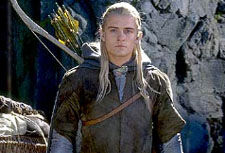
DKB: Outside of the referring to the trilogy itself for clues
to movement characteristics, did "human" fighting styles influence the
creative process? For example, in the film, it seemed to me that the Elves'
circular movements might have been reminiscent of Chinese fighting styles.
TW: The thing is, although I made extensive reference to real-world
fighting styles, I didn't necessarily give them any more weight than dance
styles, or even influences from sports. At the R&D level I was looking
for nuances of movement. If I were to start imposing specific techniques,
I would have become false to the Middle Earth cultures. Everything proceeded
from the character and the culture, so in the case of Elf swordplay, it
wasn't a matter of saying, "Oh yeah, there's this cool move from Takemusu
Aikido we can use, and how about this Northern Shaolin sword flourish?"
It was all about the congruity of weapon/armour function, body language,
dynamics and tactics. Once those were determined the techniques essentially
created themselves.
After the fact, you can deconstruct that style and see how individual
techniques resemble those of real-world systems, like Aikido or Maori Taiaha
combat, or the ringen am schwerdt (sword grappling) arts of Medieval Germany,
or even the movement of a matador dancing with a bull. I think it's great
that people can do that, but it's important to stress that during the design
process we borrowed concepts rather than techniques.
I must admit, if I had any favourite among the different styles, it
would have to be Elf swordplay. It felt as if we weren’t creating something
new, so much as rediscovering something very old. We visualised the Elves
training in these amazing temples high up in the mountains or in deep forest
glades, totally in harmony with nature. The design process involved a lot
of kinaesthetic and proxemic sensing exercises.
Here's a quote from the "Fighting Styles Guidebook" we produced for
continuity reference - "The Elves are graceful and fluid beings whose every
action is poised, neither stiff nor heavy. Their breathing is centered
in the lower abdomen. They are grounded from the waist down, yet light
and free from the waist up. As holistic fighters, all of the Elves' senses
are fully engaged in combat. Their movements are circular, fluid, evasive
and deceptive, employing spiralling deflections that flow into lightning-fast
slicing attacks. There is a magical, sleight-of-hand quality to their fighting
techniques. They do not always look directly at their enemies in combat,
seeming almost to be engaged in a kind of moving meditation."
DKB: Can you give me an example of what you might do in terms
of specifically training a stunt person, for example, one of the Uruk-hai?
What would his training day be like?
TW: To paraphrase Richard Schechner: "Rehearsal is a way of setting
an exact sequence of events. Preparations are a constant state of training
so that when a situation arises one will be ready to 'do something appropriate.'
Preparations are what a good athletic team does." (2)
That was my training philosophy in a nutshell.
Given that the stunt team was being trained during pre-production, often
weeks or months before any specific fight sequences would be rehearsed,
I focused on "preparation." I believe that it's important for stunt people
to be actors, to be able to imaginatively inhabit the characters they're
playing. Then they should be able to "do something appropriate" when they
get into rehearsals.
We began by discussing the Uruk-hai as living beings. We went through
a precis of all the research that had already been carried out. Then I
gave them breathing exercises, because the breath informs the posture -
Uruks breathe harshly and deeply, and they're enormously strong, tense
creatures, top-heavy juggernauts, with massive chest, neck, shoulder and
jaw development. I thought of them as "gorilla-bulldogs."

Also, even though the stunties would be wearing prosthetic masks and
helmets during shooting, I encouraged them to act with their faces. Uruks
snarl and grimace, as if they are in constant pain and their only relief
lies in violence. We'd improvise moving around the training room as Uruks.
Their gait is like walking uphill on railroad tracks, because as soon as
the Uruks are spawned, they get locked into heavy plate armour, so there
is a feeling of crushing weight and momentum to their stride. They have
difficulty turning quickly.
I also taught the stunt people a few words of Black Speech - that's
Tolkien's Orc language - and had them grunt orders and curses at each other.
So you have this platoon of stunt people lurching around, slamming into
each other, roaring and shoving. They had a great time and they learned
what it felt like to be Uruk-hai.
Then we used quatrains to explore how Uruk soldiers used their weapons
and moved in combat situations - everything from one-on-one fights to mass
charges on the battlefield. We knew that the Uruk-hai had very limited,
if any, formal training - maybe some basic drill work - but they were lethal
instinctive fighters, much more dangerous than the Orcs. They use their
cleavers and spiked shields pretty much interchangeably, smashing and bashing.
Their defenses were power blocks - no finesse, no deflections, just brutal
chops that could bounce an attacking weapon straight back the way it came.
Sometimes they didn't even bother to defend themselves, they'd just rely
on their armour and move straight in to the attack. They would hammer and
chop, and occasionally flip their swords around and use the back-spike
to pinion an enemy, or gut them with the prongs on their shields. Very
nasty!
The final phase was to get the stunt people to choreograph their own
quatrains, because if they were able to work creatively within the style,
it meant that they had internalised it - it had become "their thing." The
ultimate test is to be able to improvise in character.
DKB: It must have been wonderful to have the time to do all the
R&D and training of stunt people. How unusual is it to take the time
to develop fighting styles and train people in them?
TW: It was a unique situation. As far as I know, this was the
first major movie project to have devoted serious time and money specifically
towards designing fighting styles. If you're doing a historical epic, for
example, you'll normally research the fighting styles of the period and
work from there. In LotR the task was to create believable styles that
had never existed before, without falling into the anything goes/fantasy
trap.
DKB: How did all of this coordinate with the actual fight choreography?
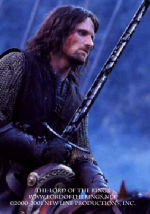 TW: I thought of the fighting styles as platforms that the various
fight and stunt coordinators could stand on. In combination with the more
general movement styles, they established a continuity between live action
and digital fights, and they allowed a congruity between the huge battle
sequences and the more personal combat scenes, like Aragorn's climactic
fight with the Uruk leader, Lurtz.
TW: I thought of the fighting styles as platforms that the various
fight and stunt coordinators could stand on. In combination with the more
general movement styles, they established a continuity between live action
and digital fights, and they allowed a congruity between the huge battle
sequences and the more personal combat scenes, like Aragorn's climactic
fight with the Uruk leader, Lurtz.
DKB: One thing I know absolutely nothing about, but it's important
to know, is how all this movement training coordinated with the special
effects work on the film. It's easy to pick out fantastic effects in, for
example, Gandalf's fight with Saruman, but I know they use computer effects
throughout fight scenes. Can you give us an example of a scene in "Fellowship"
of how this worked?
TW: If you look at the LoTR prologue battle footage, which is
set in Middle Earth's First Age, you'll get a sense of the scale of the
battles to come. There's one shot in which a broiling mass of Orcs charges
at a line of Elves, and the Elves perform a synchronised upward slash with
their swords, cutting the Orcs down in a kind of wave. There may have been,
I don't know, five thousand individual warriors on screen at that moment.
It probably won't surprise anyone to learn that Peter didn't hire five
thousand stunt people to get that shot. It was created by combining digital
effects and live-action footage.

The digital effects department also made very extensive
use of motion capture, which is a form of live-action based animation.
It's the same technology that is used in cutting-edge video games. A mocap
performer wears a black costume covered with photo-reflective markers,
and performs in a special studio with a series of cameras hooked up to
a computer system. The cameras pick up the pattern of reflections, so what
is recorded by the computer resembles a moving, three dimensional, human-shaped
constellation of stars. This pattern can then be "dressed" by artists to
create, for example, a digital stunt double for an actor, or multiplied
to create an army, or distorted or enhanced in any number of ways.
It can even be used to help "train" digital warriors who fight and move
independently, making their own decisions and reacting to their virtual
environment without any human direction.
DKB: Wow. That's incredible. Is the physical movement of the
actors enhanced in a close-quarters fight, or is it only fight choreography
and camera angles? If it's digitally enhanced, is that through use of programmed
motion capture figures? Or some combination of human and animation?
TW: I was only closely involved with the motion capture side
of things, so I'd be guessing as to the other applications. In general
you're looking at a whole range of SFX techniques. For example, I can tell
you that Orlando Bloom (Legolas) was a very enthusiastic Elf and really
got into that style, but some of his rapid-fire archery had to be digitally
enhanced because humans just can't shoot that fast.
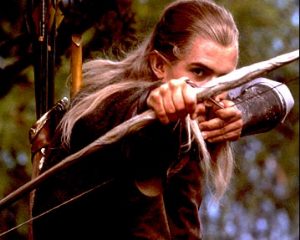
DKB: I know you have a background in various martial arts. How
did that training, specifically, help or hinder your development of the
fighting styles?
TW: It's hard to answer that without getting all Zen, simply
because my training background supported literally every aspect of the
process. Everything. I've studied many different martial arts, from a wide
range of cultures and historical periods. Different styles organise themselves,
their curricula and so-on, almost as microcosms of their parent cultures,
their founders' personalities, etc. For example, Brazilian Capoeira is
a very intuitive art, very emotional and spontaneous. It's both urban and,
in a sense, tribal, which is probably why it's becoming popular in the
big cities. You can contrast that with something like Tae Kwon Do, which
is organised on a more military model, with overtones of modern athletic
training. Then you have old-school, British style professional wrestling
as a sort of blue-collar, combative commedia del' arte. Maori martial arts
are formal and ritualistic, and there's a distinct Polynesian depth to
the ritual. And so-on. I've ended up with a very holistic, yin-yang perspective
on the whole field.
When I look at any system I tend to see it as a unique combination or
application of stylistically neutral, universal principles. For example,
I'm heavily involved in the revival of historical European combat styles.
One 15th century German master, Sigmund Ringeck, wrote of the principles
of "Fuehlen" and "Indes." Basically these are tactile sensitivity to another
fighter's movement, and a sense of timing derived from that sensitivity,
so that you can intuitively counter their movement. Ringeck was talking
specifically about the martial arts of his culture, but if you look closely,
virtually every system applies these principles - Asian, European, African,
Polynesian, modern, ancient, battlefield, sport, whatever. They don't always
articulate it, but it's always there in some form or another. And then
in performing arts there's a modern dance discipline called Contact Improvisation
that is almost entirely founded on these two basic principles.
DKB: Obviously the martial arts background then was very important.
The reason I was asking was (and this may be an unfair question for someone
who has trained in both stage combat and martial arts) there seems to be
some tension between martial arts and stage combat people, at least in
some quarters. I had an opportunity to spend a little time with some of
the people involved in recreating or restoring Western European martial
arts, and they were adamant that they not be confused with stage combat
artists or (worse) the Society for Creative Anachronism. Do you feel any
conflict, or do you feel it's part of some sort of continuum?
TW: Most of it comes down to the difference between the professional
and hobbyist perspectives. You can't take it too seriously. It's a pity,
a missed opportunity if it actually causes conflicts between people.
It's very important to remember that as a performing art, stage combat
is much closer to dance than fighting. The paradigms are "with" and "for."
Actors move safely with each other, for the entertainment of an audience.
That is their priority and perspective. The martial arts paradigm is, excepting
special cases such as Aikido, "against." Martial artists compete against
opponents in sparring, or fight against enemies in real combat. That's
an over-simplification of course, but bear with me.
A fight director creates a representation of physical conflict, a dramatic
illusion that is subject to a whole raft of artistic decisions, of which
the technical choreography is only one aspect. Many people are very passionate
about their martial arts, and sometimes they can get frustrated when they
see "their thing" being represented in a dramatic context, rather than
being presented as it would be in an educational demonstration or a sparring
match, or even in a battle, for that matter. It's the difference between,
say, "Ben Hur" and a documentary about ancient Rome.
Some of the criticism I've seen offered in this debate is valid. There
are definitely cliches in fight direction, the residue of early Hollywood
screen fencing, for example, which still has its place, but not at the
head of the table. On the other hand, very few martial arts-oriented critics
understand the practical realities of film-making - the production hierarchy,
the logistics of rehearsal time, budget issues and so-on. The conditions
that apply to the hobby just do not factor into the business of film-making.
It's a different ballgame.
As a martial artist, I'm interested in re-creating the historical European
combat systems accurately. As a professional fight director, I relish the
chances I get to represent these arts on stage or on the screen. The challenge
lies in making artistically mature choices and balancing historical accuracy
and combat realism with the requirements of safety, story and character.
The good news is that there is an emerging "New School" of fight directors
who are moving the art in new directions, including serious research into
authentic historical styles and new methods for creating ultra-realistic
fight choreography. Much of this depends on research materials and technologies
that weren't available even a few years ago. In the meantime, I'd encourage
all martial artists with an interest in this sort of thing to be patient
and open-minded. If positive communication becomes the norm, then everyone
wins.
DKB: By the way, congratulations on LoTR's Oscar wins. Personally,
I thought it deserved better in terms of categories.
TW: We may have to wait until the whole trilogy has been released
…
DKB: You were mentioning the constraints on fight choreographers
with regard to budget and timetable, but what about personnel? Many years
ago, I choreographed an Equity Showcase production of Cyrano de Bergerac,
where I quickly found out the limitations of working with actors who have
variable skills to say the least. Did your work on LoTR involve any actors,
or were you fortunate enough to work mainly with experienced stunt people?
TW: I trained some of the actors and doubles that were available
during the pre-production phase, mostly working on the movement styles.
DKB: Having considered some of the things we discussed above,
I know of at least one fight choreographer/stage combat teacher who insists
that stage combat is a form of martial art. I happen to disagree. Do you
have an opinion?
TW: In the abstract human potential sense, sure, stage combat
and martial arts training can offer similar benefits - increased sense
of well-being, improved co-ordination, etc. But really, you could say the
same for any dance style and most sports. It comes down to the paradigms
I was talking about earlier - a performing art is cooperative and audience-centered
and a martial art is, at least theoretically, antagonistic. There are overlap
points at the historical and cultural levels, everything from Beijing Opera
to professional wrestling, and it’s true that martial arts often evolve
into performing arts or include a performance component.
Some aspects of martial arts training are essentially forms of fight
choreography, and many fight directors make some use of martial arts methodology.
I developed a form of full-contact, armoured freestyle combat called "jamming"
during the LoTR style design process. Still, I would say that performance
combat and martial arts are essentially very distinct disciplines.
DKB: Are you still working on the other LoTR films, or are you
moving on? What's next for you?
TW: The style designs were all largely established during pre-production.
I’ve just been invited to tour Japan with the Washington Opera Company’s
productions of “Otello” and “Tosca.” I’m looking forward to that one, we’ll
be working with Placido Domingo. Then I’ll be back in New Zealand for a
month or so, before heading off to Europe for a teaching tour.
I'm also trying to squeeze in a book and video project, so things are
humming along quite nicely.
DKB: Thanks a lot for your time.
TW: Thank you.
Bibliography
1. Tolkien, J.R.R. The Fellowship of the Ring.
New York: Houghton Mifflin Company, 1994, p. 391.
2.Schechner, Richard. “From Ritual to Theatre and Back,”
Ritual,
Play and Performance: Readings in the Social Sciences/Theatre NY: Seabury
Press, 1976, pp. 196-22.
Copyright 2002 Deborah Klens-Bigman
 Tony Wolf is one of the legion of behind the scenes workers blessed with
a unique and exacting challenge - rather than accomplish the fight and
battle scenes with generic fight choreography, director Jackson decided
to have him design movement styles for the different cultures and species
of combatants: Orcs, Uruk-hai and others. Drawing on his expertise in martial
arts, combat choreography and a wide variety of indigenous fighting styles
from around the world, Tony created unique styles and taught them to teams
of stunt people. This method then allowed those in charge of the actual
fight scenes to work within a certain framework of tactics and body mechanics
with trained personnel. Tony also worked with motion capture technicians
to create the epic battle scenes, such as the one described in the quote
above.
Tony Wolf is one of the legion of behind the scenes workers blessed with
a unique and exacting challenge - rather than accomplish the fight and
battle scenes with generic fight choreography, director Jackson decided
to have him design movement styles for the different cultures and species
of combatants: Orcs, Uruk-hai and others. Drawing on his expertise in martial
arts, combat choreography and a wide variety of indigenous fighting styles
from around the world, Tony created unique styles and taught them to teams
of stunt people. This method then allowed those in charge of the actual
fight scenes to work within a certain framework of tactics and body mechanics
with trained personnel. Tony also worked with motion capture technicians
to create the epic battle scenes, such as the one described in the quote
above.




 TW: I thought of the fighting styles as platforms that the various
fight and stunt coordinators could stand on. In combination with the more
general movement styles, they established a continuity between live action
and digital fights, and they allowed a congruity between the huge battle
sequences and the more personal combat scenes, like Aragorn's climactic
fight with the Uruk leader, Lurtz.
TW: I thought of the fighting styles as platforms that the various
fight and stunt coordinators could stand on. In combination with the more
general movement styles, they established a continuity between live action
and digital fights, and they allowed a congruity between the huge battle
sequences and the more personal combat scenes, like Aragorn's climactic
fight with the Uruk leader, Lurtz.

